Game Review
by Todd Ciolek,Final Fantasy XIII
PlayStation 3, Xbox 360
| Description: | 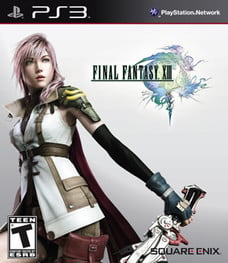 |
||
In a world overseen by the floating metropolis of Cocoon, six humans are enlisted to serve one of the godlike creatures known as the fal'Cie. Hunted by the forces of Cocoon, the cursed heroes make their way across the edges of civilization and into the untamed lands of Pulse. As it goes in most Final Fantasy titles, their long journey is strewn with hostile encounters and personal revelations. |
|||
| Review: | |||
Final Fantasy changes. It might look like a stagnant series, with each game starring glamorous young heroes distinguished only by their improbable hairstyles and penchants for melodrama. Yet every Final Fantasy also tries new things, usually altering just enough in gameplay and storytelling to alienate some longtime fans. And that's kept the series remarkably fresh for something with over a dozen proper entries. Final Fantasy XIII is an experiment in some ways and a throwback in others, streamlining combat while indulging in the glitzy theatrics that made Final Fantasy what it is today. It's also a test of just how much bland introduction a player can take. Final Fantasy XIII borrows a common sight from the anime/RPG milieu: a massive city called Cocoon floats above a savage wilderness called Pulse, and both lands are governed by powerful beings called fal'Cie (get it?). These seemingly callous deities mark humans as their servants, branding them as l'Cie and putting them to use in dangerous and vaguely understood wars. When a fragile young woman named Serah is deemed a l'Cie and dragged off to Cocoon, her sister Lightning chases after her, with largely unwanted help from Serah's moronic fiancé Snow and his band of rebels. Snow and Lightning soon become l'Cie themselves, as do others connected to them: the muffiny-haired pilot Sazh is searching for his Cocoon-abducted son, the gloomy kid Hope's mother died fighting beside Snow, and the relentlessly upbeat Vanille is apparently just tagging along. And then there's Fang, a dedicated spearfighter who shares Vanille's strange background and Australian accent. Every Final Fantasy needs some time to get going. The first few hours typically see the player fighting some tutorial-heavy battles, meeting the lead characters, and learning about the world around them. There is a point, however, where the storyline kicks into gear, a full party is assembled, and the game gives the chance to explore and customize freely. In most Final Fantasies, this point comes around the three-hour mark. Final Fantasy XIII takes 15 hours to get interesting. Fifteen. During this astoundingly long setup, the characters trek through the outskirts of their civilized world with the Cocoon military pressing close behind. The group splits into pairs: Hope follows the determined Lightning, Sazh learns to tolerate Vanille's insipid ways, and Snow and Fang work for a shadowy benefactor. They resolve some predictable conflicts, have a few minor breakthroughs, and generally don't do much more than establish the world and narrate flashbacks to happier times. Meanwhile, the Cocoon forces remain a vague threat, driven to keep the peace by exterminating anyone infected by the land of Pulse.
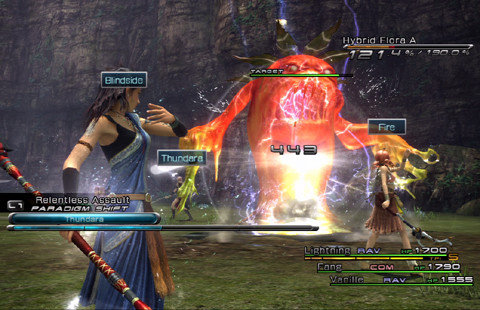 The game's six playable characters similarly divide their appeal: Snow and Hope are insufferable despite the best efforts of their voice actors, and Vanille and Lightning are initially unsympathetic. Vanille's constant attempts at comedy are awkward, and Lightning's far too distant and cold, as though the writers were so intent on creating a tough, competent heroine that they forgot to make her at all compelling. Sazh, who many expected to be a comical and borderline-offensive stereotype, comes off the best, as he's an older, wearier voice in a cast of headstrong kids. There's also the likeably brusque Fang, though she's the last of the characters to join. It'd be easier to endure Final Fantasy XIII's dismal crawl of a plot if the battle system picked up sooner. The game pares down the menu-driven system of a typical Final Fantasy, letting players control only the party's leader through commands. The other two members run on automatic during battle, and the entire group is governed by the “Paradigm Shift” system. Teams are formed with each character in a designated role: Commandos and Ravagers attack, Medics heal, Synergists and Saboteurs cast weakening or strengthening magic, and so on. It seems needlessly cumbersome at first: instead of picking battle directions from one large menu system, players have to switch between Paradigms if they want to do something as simple as healing before attacking.
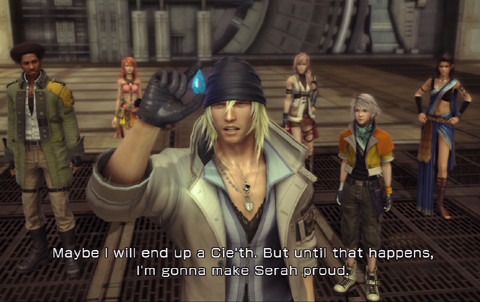 Final Fantasy XIII is slow to let players take control. The game limits itself to two-character parties for most of that long opening, and so the battle system seems much more repetitive and limited than it should be. It also cranks up the annoyance of having to peck out commands from a menu (or use auto-battle) when you're guiding only one character. Why not let the player control Lightning or Fang like the lead in a full-on action game? Every Final Fantasy has allowed players to direct each individual party member; even Final Fantasy XII, which offered the option of AI-controlled characters. The Final Fantasy series is often criticized as lacking interaction, and XIII almost parodies the idea of someone actually playing the game. The game's pacing bogs down even further with its limited scope. Devoid of towns to visit, the first dozen or so stages are linear treks through hallways, jungles, canyons, junkyards, ice fields, and other gorgeous areas that offer minimal exploration. There are no shops beyond a network of save points, and rarely do the characters encounter any normal citizens. The enemies are repetitive as well, though at least they're easy to see and avoid. Final Fantasy XIII even overhauls the traditional RPG approach to upgrading weapons and gaining levels. Arms and accessories can be enhanced with various items grabbed from dead enemies, and it's a fairly straightforward process. Stranger is the Crystarium system, which guides character development around a circular map reminiscent of Final Fantasy X's Sphere Grid. Every Final Fantasy XIII party member gets a different crystal chain for each of his or her combat roles, and spending experience points unlocks one stat boost or ability after another. That's Final Fantasy XIII for its first dozen or so hours: a lengthy slog through simplistic battles and a cast of half-boring characters. It's easy to set the game aside by this point, and many will surely do that at the thought of fighting another routine two-character battle or hearing Vanille squeak her way through comedy relief.
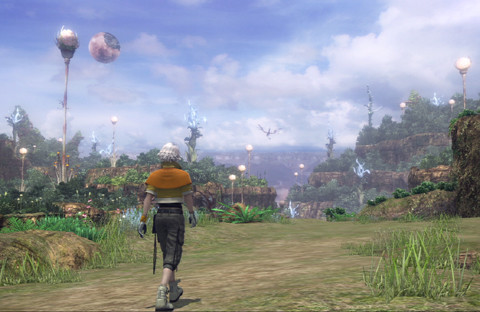 Yet it all improves. Around the 15-hour point, the game's story turns on, a full three-character party is assembled, some villains emerge, and Fang makes her entrance. At 20 or 25 hours, the game's lower world opens, with plenty of venues to explore and lots of side missions to tackle. The battle system becomes far more complex and challenging once three characters are in play, and the speed of combat almost outweighs the lack of control. Every battle is a race to exploit an enemy's weakness and build up combos, resulting in a “staggered” foe that's much easier to destroy. The Crystarium also becomes more intriguing as the game goes on. At first it's easy to bring every party member up to speed, but rising experience-point costs soon force players to choose their paths carefully. Even the characters improve. Lightning becomes a more appealing lead, Vanille explains why she acts like such a twit, Sazh and Fang get considerably more exposure, and even Hope and Snow become tolerable. There is indeed an ambitious plot behind Final Fantasy XIII, and while it's carried off with overblown rage-against-the-gods speeches and bizarre psychic-science concepts, it's not without its moments. The reckless grandeur of it all can be fun, whether it's in airship fleets whirling through spiked cities, Lightning flipping through the air as she unloads on a Cocoon monstrosity, or the rough camaraderie of a group of misfits cursed by demigods. The game sometimes loses itself in its own invented terms, though there's a directory of plot points and explanations of how the fal'Cie turn humans into l'Cie who become Cie'th if they don't complete their Focus, but only Pulse l'Cie are considered enemies of Cocoon l'Cie because the Sanctum says so. Everyone got that? Final Fantasy XIII doesn't fit properly among its predecessors. Its concept of revolutionaries shattering a gray, controlled society is straight out of Final Fantasy VII, and the glossy, colorful look and Tetsuya Nomura character designs come from the same playbook that drove Final Fantasy X. Yet the game's lack of traditional battle systems puts it far from previous Final Fantasies. Indeed, fans of the relatively dignified Final Fantasy XII may find its successor a juvenile, neon-hued nightmare, lacking in restraint and cohesion. If Final Fantasy VIII is all about high school and Final Fantasy X is spring break, Final Fantasy XIII is an overlong post-college trip through a day-glow future Europe where you're forced to walk everywhere.
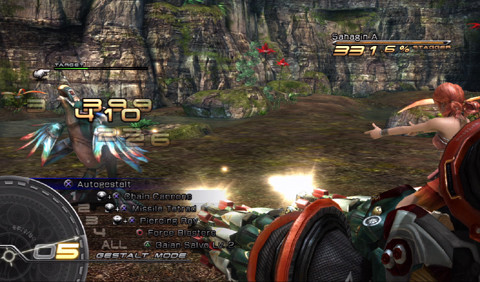 Final Fantasy XIII is, of course, an exceptionally pretty game. Square's gift for the cinematic shows in the spectacular scenery, whether it's a gaping valley or the hull of an armored monorail car (it's all a little sharper on the PlayStation 3, though most won't notice the difference). The characters also look great, though the six mainstays are clearly more detailed than most of the supporting cast. The game's style reaches an insane, gaudy apex with its Summons, acquired through strange and difficult battles. They're transformable mechanized versions of Final Fantasy icons, seemingly tailored for a yet-unproduced toy line: Brynhildr morphs into a roadster, Odin becomes a mechanical horse, and Hecatoncheir turns into a lumbering minigun beast. Masashi Hamauzu's soundtrack is strong, and it's to his credit that that the game's battle theme never grates. The new theme song, “My Hands” by Multi-Platinum-Selling Artist Leona Lewis, replaced the game's original theme in the West, but it actually blends into things. Despite the narrow window between the game's Japanese and English releases, Square didn't cut corners on the voice acting. Directed by Jack Fletcher, the dub shows strong performances, with Reno Wilson's Sazh stealing many scenes, and even the more annoying characters (that'd be Hope and Snow) are acted as well as they ever could be. The only major oddity is Georgia van Cuylenburg, who can't seem to decide how much of an Aussie accent Vanille should have. As for the dialogue itself, it finds the translators making the most of a frequently nonsensical drama where a line like "Moms are tough" is meant to carry pathos. It's a shame that Final Fantasy XIII's script never allows for the elegant tone of Final Fantasy XII, but the game stays on par with a good anime dub: convincing, well-synced, and only ridiculous when the underlying story can't help it. There's an enjoyable RPG deep inside Final Fantasy XIII, hiding behind a sluggish opening act that tests the player's patience. A smooth battle system and some engaging characters save the game from complete failure, though it's far too hokey and badly paced to stand anywhere near the best of the series. Final Fantasy XIII's good side eventually wins out, even if the struggle takes away too much and gives too little in return. |
|
The views and opinions expressed in this article are solely those of the author(s) and do not necessarily represent the views of Anime News Network, its employees, owners, or sponsors.
|
| Grade: | |||
Overall : B
Graphics : A
Sound/Music : B+
Gameplay : B-
Presentation : A-
+ Fluid battles, amazing visual quality |
|||
|
discuss this in the forum (57 posts) |
this article has been modified since it was originally posted; see change history |
|||